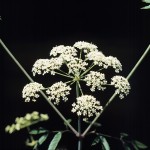Spotted Water Hemlock
Cicuta maculata
Apiaceae
Description
Spotted Water Hemlock is a stout herb in the Carrot family (Apiaceae), 2 to 6 feet or 0.6 to 1.8 m tall, arising from a thickened tuberous base bearing one to several fleshy or fleshy-tuberous roots greatly thickened in their upper portion. Its short rootstocks have air cavities or chambers separated by cross-partitions containing a yellowish liquid that turns reddish brown when exposed to air. According to John Kingsbury in Poisonous Plants of the United States and Canada, “This genus is considered by many authorities to be the most violently poisonous plant of the Northern Temperate Zone.” Kingsbury gives one way to differentiate this species from other Apiaceae: that is, having fascicled, tuberous roots; chambered, swollen rootstock; yellowish, oily drops, and a pungent odor. Illinois Wildflowers adds “…the lateral veins of the leaflets extend to the notches between the teeth, rather than to the tips, along the leaf margins.” This is NOT a characteristic of other Apiaceae. The stems are hollow except at the nodes and may be pale green, pink, or reddish purple, often with prominent longitudinal veins. Once to three times pinnately divided leaves are alternate, with petioles wrapping around the main stem. They grow up to 15 inches long and 10 inches wide. The lance-shaped leaflets are 1 to 5 inches long and have saw-like margins. The fern-like leaves are much smaller on the upper stem. Small white or greenish flowers are arranged at the ends of the stems in numerous umbrella-shaped clusters. These clusters are on the terminal or axillary peduncles and can be 8 to 18 cm across and composed of 10 to 20 umbellets each with 12-15 tiny flowers of five white petals having notched tips. Spotted Water Hemlock blooms June through October. When flowering exhausts the stored reserves in the roots and before the roots disappear, the plant sends out a lateral shoot which over-winters and results in a new plant in the spring. Even though it is not a true perennial, the plant tends to persist in the same place year to year in this way.Habitat
Spotted Water Hemlock is found in east, central and north Texas. Because it requires ample water, it is found only near streams, marshes, wet meadows, and permanent springs. It prefers full to partial sun.Toxic Agent
The lower stalk and chambered rootstock of this plant contain most of its toxic alcohol, but hazardous concentrations can also occur in very young leaves. All parts of the plant are toxic. Mature and dried leaves are not toxic. This fast-acting toxin (cicutoxin) can cause death between 1 and 8 hours after consumption in all animals and including humans.Signs of Livestock Ingestion
The toxic alcohol is a convulsant, and the clinical signs are the result of its action on the central nervous system. They include: Muscle tremors; Salivation; Grinding of the teeth; Convulsions; Death.Management Strategies
Water Hemlock poisoning is not a significant livestock problem in Texas. Animals will die if they are forced to consume the young plant. Do not pull plants for animals to consume, as this will make the highest concentration of toxin available (in the chambered rootstock) and can easily cause fatal poisoning.Images
Plant Characteristics
Flower Color: Green, White
Seed Type: Non-Encapsulated
Duration: Biennial, Perennial
Stem Texture: Hairless/Smooth
Growth Habit: Forbs/Broadleaf
Leaf Shape
 : Palmately Compound
: Palmately Compound
Season: Warm
Distribution
 : 01 - Pineywoods, 02 - Gulf Prairies and Marshes, 03 - Post Oak Savannah, 04 - Blackland Prairies, 05 - Cross Timbers and Prairies, 07 - Edwards Plateau, 08 - Rolling Plains
: 01 - Pineywoods, 02 - Gulf Prairies and Marshes, 03 - Post Oak Savannah, 04 - Blackland Prairies, 05 - Cross Timbers and Prairies, 07 - Edwards Plateau, 08 - Rolling Plains
Distributions
Distribution refers to the ecological region in Texas that a plant has been found. You can also view a clickable map.
Book: Toxic Plants of Texas (B-6105)
Collection: Toxics, Wild Flowers
Livestock Affected: Cattle, Goats, Horses, Sheep
Livestock Signs: Convulsions, Excess Salivation, Sudden Death, Trembling







